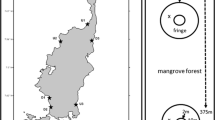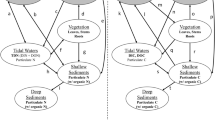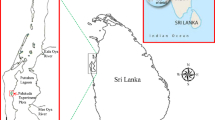Abstract
Mangrove forest coverage is increasing in the estuaries of the North Island of New Zealand, causing changes in estuarine ecosystem structure and function. Sedimentation and associated nutrient enrichment have been proposed to be factors leading to increases in mangrove cover, but the relative importance of each of these factors is unknown. We conducted a fertilization study in estuaries with different sedimentation histories in order to determine the role of nutrient enrichment in stimulating mangrove growth and forest development. We expected that if mangroves were nutrient-limited, nutrient enrichment would lead to increases in mangrove growth and forest structure and that nutrient enrichment of trees in our site with low sedimentation would give rise to trees and sediments that converged in terms of functional characteristics on control sites in our high sedimentation site. The effects of fertilizing with nitrogen (N) varied among sites and across the intertidal zone, with enhancements in growth, photosynthetic carbon gain, N resorption prior to leaf senescence and the leaf area index of canopies being significantly greater at the high sedimentation sites than at the low sedimentation sites, and in landward dwarf trees compared to seaward fringing trees. Sediment respiration (CO2 efflux) was higher at the high sedimentation site than at the low one sedimentation site, but it was not significantly affected by fertilization, suggesting that the high sedimentation site supported greater bacterial mineralization of sediment carbon. Nutrient enrichment of the coastal zone has a role in facilitating the expansion of mangroves in estuaries of the North Island of New Zealand, but this effect is secondary to that of sedimentation, which increases habitat area and stimulates growth. In estuaries with high sediment loads, enrichment with N will cause greater mangrove growth and further changes in ecosystem function.




Similar content being viewed by others
References
Aerts R (1996) Nutrient resorption from senescing leaves of perennials: are there general patterns? J Ecol 84:597–608
Alongi DM, Pfitzner J, Trott LA, Tirendi F, Dixon P, Klumpp DW (2005) Rapid soil accumulation and microbial mineralization in forests of the mangrove Kandelia candel in the Jiulongjiang estuary, China. Estuarine Coast Shelf Sci 63:605–618
Baudion E, Benizri E, Guckert A (2003) Impact of artificial root exudates on the bacterial community structure in bulk soil and maize rhizosphere. Soil Biol Biochem 31:1183–1192
Beard C (2006) Photosynthetic responses of the mangove, Avicennia marina subsp. australasica to frost and chilling temperatures during a New Zealand winter. PhD thesis, University of Waikato, New Zealand
Burns BR, Ogden J (1985) The demography of the temperate mangrove (Avicennia marina (Forsk.) Vierh.) at its southern limit in New Zealand. Aust J Ecol 10:125–133
Chapin FS III, Van Cleve K (1989) Approaches to studying nutrient uptake, use and loss in plants. In: Pearcy RW, Ehleringer J, Mooney HA, Rundel PW (eds) Plant physiological ecology. Field methods and instrumentation. Chapman and Hall, London, pp 185–207
Cintrón G, Schaffer-Novelli Y (1984) Methods for studying mangrove structures. In: Saenger SC, Snedaker JG (eds) The mangrove ecosystem: research methods. Monographs in oceanographic methodology, vol 8. UNESCO, Paris, pp 91–113
Ellis J, Nicholls P, Craggs R, Hofstra D, Hewitt J (2004) Effects of terrigenous sedimentation on mangrove physiology and associated macrobenthic communities. Mar Ecol Prog Ser 270:71–82
Ellison JC (1998) Impacts of sediment burial on mangroves. Mar Pollut Bull 37:8–12
Ellison AM, Farnsworth EJ (1996) Spatial and temporal variability in growth of Rhizophora mangle saplings on coral cays: links with variation in insolation, herbivory, and local sedimentation rate. J Ecol 84:717–731
Eschen R, Muller-Scharer H, Schaffner U (2006) Soil carbon additions affects plant growth in a species-specific way. J Appl Ecol 43:35–42
de Lange WP, de Lange PJ (1994) An appraisal of factors controlling the latitudinal distribution of mangrove (Aviennia marina var. resinifera) in New Zealand. J Coast Res 10:539–548
de Olff H, Leeuw J, Bakker JP, Platerink RJ, van Wijnen HJ, de Munck W (1997) Vegetation succession and herbivory in a salt marsh: changes induced by sea level rise and silt deposition along an elevational gradient. J Ecol 85:799–814
Ewing K (1996) Tolerance of four wetland plant species to flooding and sediment deposition. Environ Exp Bot 36:131–146
Feller IC (1995) Effects of nutrient enrichment on growth and herbivory of dwarf red mangrove (Rhizophora mangle). Ecol Monogr 65:477–505
Feller IC, Whigham DF, McKee KL, O’Neill JP (2002) Nitrogen vs. phosphorus limitation across an ecotonal gradient in a mangrove forest. Biogeochemistry 62:145–175
Feller IC, Whigham DF, McKee KL, Lovelock CE (2003) Nitrogen limitation of growth and nutrient dynamics in a mangrove forest, Indian River Lagoon, Florida. Oecologia 134:405–414
Feller IC, Lovelock CE, McKee KL (2007) Nutrient addition differentially affects ecological processes of Avicennia germinans in nitrogen versus phosphorus limited mangrove ecosystems. Ecosystems. doi:10.1007/s10021-007-9025-2
Gattuso J-P, Frankignoulle M, Wollast R (1998) Carbon and carbonate metabolism in coastal aquatic ecosystems. Annu Rev Ecol Syst 29:405–434
Hemminga MA, van Soelen J, Mass YEM (1998) Biomass production in pioneer Spartina angelica patches: evidence for the importance of seston particle deposition. Estuarine Coast Shelf Sci 47:797–805
Howarth RW, Fruci JR, Sherman D (1991) Inputs of sediment and carbon to an estuarine ecosystem: Influence of land use. Ecol Appl 1:27–39
Jonasson S, Vestergaard P, Jensen M, Michelsen A (1996) Effects of carbohydrate amendments on nutrient partitioning, plant and microbial performance on a grassland-shrub ecosystem. Oikos 75:220–226
Koch MS, Snedaker SC (1997) Factors influencing Rhizophora mangle L. seedling development in Everglades carbonate soils. Aquat Bot 59:87–98
Lin G, Sternberg LSL (1992) Differences in morphology, carbon isotope ratios, and photosynthesis between scrub and fringe mangroves in Florida, USA. Aquat Bot 45:303–13
Lovelock CE, Feller IC, McKee KL, Engelbrecht BM, Ball MC (2004) The effect of nutrient enrichment on growth, photosynthesis and hydraulic conductance of dwarf mangroves in Panama. Funct Ecol 18:25–33
Lovelock CE, Ball MC, Choat B, Engelbrecht BMJ, Holbrook NM, Feller IC (2006) Linking physiological processes with mangrove forest structure: Phosphorus deficiency limits canopy development, hydraulic conductivity and photosynthetic carbon gain in dwarf Rhizophora mangle. Plant Cell Environ 29:793–802
Lugo AE, Snedaker SC (1974) The ecology of mangroves. Annu Rev Ecol Syst 5:39–64
McGraw JP, Garbutt K (1990) Demographic growth analysis. Ecology 71:1199–2004
McKee KL (1993) Soil physicochemical patterns and mangrove species distribution—reciprocal effects? J Ecol 81:477–487
McKee KL (1996) Growth and physiological responses of neotropical mangrove seedlings to root zone hypoxia. Tree Physiol 16:883–889
McKee KL, Feller IC, Popp M, Wanek W (2002) Mangrove isotopic (δ15N and δ13C) fractionation across a nitrogen vs. phosphorus limitation gradient. Ecology 83:1065–1075
McMillan C (1971) Environmental factors influencing seedling establishment of the black mangrove on the east coast of Texas. Ecology 52:927–930
Nye PH, Tinker PB (1977) Solute movement in the soil–root system. Blackwell, Oxford
Orwin KH, Wardle DA, Greenfield LG (2006) Ecological consequences of carbon substrate identity and diversity in a laboratory study. Ecology 87:580–593
Pezeshki SR, De Laune RD, Pardue JH (1992) Sediment addition enhances transpiration and growth of Spartina alterniflora in deteriorating Louisiana Gulf Coast salt marshes. Wetland Ecol Manage 1:185–189
Raich JW, Schlesinger WH (1992) The global carbon dioxide flux in soil respiration and its relationship to vegetation and climate. Tellus 44B:81–99
Schwarz AM (2004) Contribution of photosynthetic gains during tidal emersion to production of Zostera capricorni in a North Island, New Zealand estuary. N Z J Mar Freshw Res 38:809–818
Thrush SF, Hewitt JE, Cummings VJ, Ellis JI, Hatton C, Lohrer A, Norkko A (2004) Muddy waters: elevating sediment input to coastal and estuarine habitats. Front Ecol Evol 2:299–306
Tilman D (1988) Plant strategies and the dynamics of plant communities. Princeton University Press, Princeton
Van der Werf A, Visser AJ, Schieving F, Lambers H (1993) Evidence for optimal partitioning of biomass and nitrogen at a range of nitrogen availabilities for a fast- and a slow-growing species. Funct Ecol 7:63–74
Vitousek PM, Walker LR, Whiteaker LD, Matson PA (1993) Nutrient limitations to plant growth during primary succession in Hawaii Volcanoes National Park. Biogeochemistry 23:197–215
Walker TW, Syers JK (1976) The fate of phosphorus during pedogenesis. Geoderma 15:1–15
Walls RL, Heller Wardrop D, Brooks RP (2005) The impact of experimental sedimentation and flooding on the growth and germination of floodplain trees. Plant Ecol 176:203–213
Weisner SEB (1996) Effects of an organic sediment on performance of young Phragmites australis clones at different water depth treatments. Hydrobiologia 330:189–194
Acknowledgments
Awards from the Smithsonian Institution and a WISC award from the American Association for the Advancement provided support for CEL, ICF and JE. This study was funded by the New Zealand Foundation for Research, Science and Technology (C01X0024, C01X0215, and C01X0307). Thanks to Jane Halliday, Greig Funnell, Deborah Hofstra, Rupert Craggs, Louise Hunt, Paul Buisson and many other NIWA staff who assisted with field measurements, and to Ray Feller for his assistance in the field and laboratory.
Author information
Authors and Affiliations
Corresponding author
Additional information
Communicated by Marilyn Ball.
Rights and permissions
About this article
Cite this article
Lovelock, C.E., Feller, I.C., Ellis, J. et al. Mangrove growth in New Zealand estuaries: the role of nutrient enrichment at sites with contrasting rates of sedimentation. Oecologia 153, 633–641 (2007). https://doi.org/10.1007/s00442-007-0750-y
Received:
Accepted:
Published:
Issue Date:
DOI: https://doi.org/10.1007/s00442-007-0750-y




